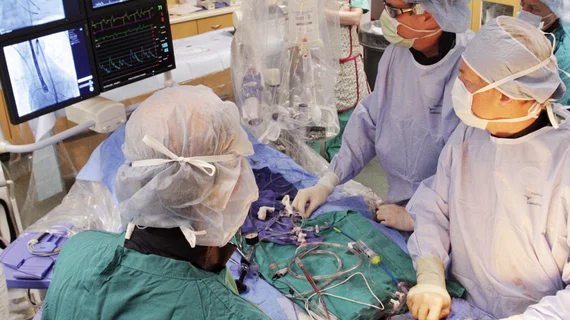Atrial fibrillation after TAVR linked to much higher risk of death, heart failure
Patients who develop atrial fibrillation (AFib) for the first time after transcatheter aortic valve replacement (TAVR) face a heightened risk of all-cause mortality and heart failure, according to new research published in the International Journal of Cardiology: Heart and Vasculature.[1]
“TAVR is a well-established treatment intervention in patients with symptomatic, severe aortic stenosis, and recent clinical trials have expanded the indication from elderly high-risk patients by showing benefit also in elderly patients with low surgical risk score,” wrote first author Jeppe Kofoed Petersen, MB, a cardiologist with Copenhagen University Hospital in Denmark, and colleagues. “As the number of TAVR procedures are increasing, the risk of complications such as new-onset AFib needs further investigation.”
Petersen et al. examined data from more than 6,800 patients who underwent TAVR in Denmark from 2008 to 2021. Only patients who survived 30 days following the procedure were included. While 62.1% of patients had no history of AFib and did not develop AFib after TAVR, 33.6% of patients already had a history of AFib when they underwent TAVR and 4.3% went on to develop “first-time detected” AFib after TAVR.
Patients with a history of AFib were the most likely to present with comorbidities such as diabetes, peripheral artery disease, chronic kidney disease, a history of stroke and a history of percutaneous coronary intervention. Patients with first-time detected AFib were much more likely to undergo TAVR with transapical access than patients from the other groups.
All-cause mortality after two years was 8.8% among patients with no AFib, 19% among patients with a history of AFib and 20.6% among patients with first-time detected AFib after TAVR.
“Our data yielded an increased associated rate of mortality with a maximum of two years of follow-up in patients with first-time detected AFib,” the authors wrote. “Furthermore, compared with patients with a history of AFib, our results demonstrate a higher associated rate of mortality in patient with first-time detected AFib. These associations were substantial, even after adjustments for factors known to be associated with adverse outcomes, and the findings were consistent, irrespective of sex and calendar year.”
The hospital admission rate for heart failure symptoms after two years, meanwhile, was 5.7% among patients with no AFib, 18.6% among patients with a history of AFib and 13.7% among patients with first-time detected AFib after TAVR.
“While causality between the risk of heart failure admissions and type of AFib cannot be established in the context of the study design, our results contribute to the sparse knowledge on this matter and further emphasize the need for increased awareness in this high-risk group of patients. Further, there is merit in developing clinical risk prediction models for outcomes such as congestive heart failure; particularly given our relative and absolute risk estimates.”
The team did note that its research had certain limitations. For example, some of the patients receiving their first AFib diagnosis after TAVR could have possibly had a history of AFib prior to the procedure that simply went undiagnosed; this is why they focused on first-time detected AFib as opposed to new-onset AFib. However, the team wrote, considering how many diagnostic tests were performed on each patient prior to TAVR, it is “unlikely” patients with first-time detected AFib actually have an unknown history of AFib.
“These findings illuminate a high-risk group of patients and emphasize the need for increased awareness and further research,” the authors concluded.
Read the full analysis here.

